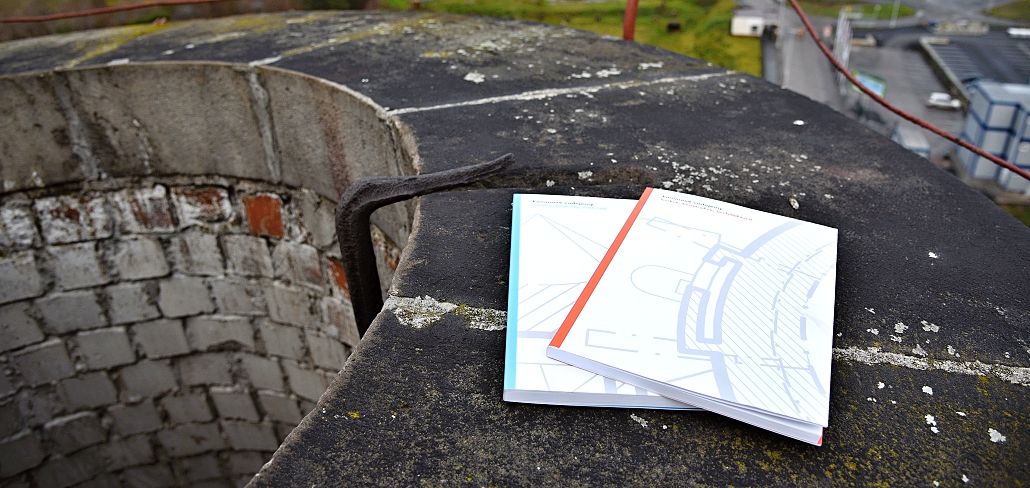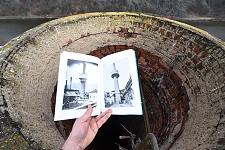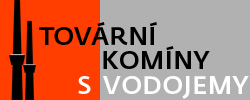|
Komínové vodojemy. Funkce,
konstrukce, architektura
Martin Vonka,
Robert Kořínek
ISBN
978-80-01-05774-2
104 stran, 56
fotografií, dobových vyobrazení a schémat
Anotace
Zásobování vodou
průmyslových areálů mělo v minulosti mnoho podob a řadu
technických řešení. Jedním z nich bylo od konce 19. století
budování tzv. komínových vodojemů, které bývaly osazovány na
dříky komínů. Došlo tak k nápaditému a výhodnému doplnění komína
o další funkci – vodojem.
S myšlenkou
umístit nádrž na vodu na tovární komín přišel poprvé profesor
Otto Intze z Cách v osmdesátých letech 19. století. Z Německa se
pak jejich výstavba rozšířila do dalších zemí včetně
Rakouska-Uherska. První tovární komíny s vodojemem se na našem
území objevily na přelomu 19. a 20. století. Nejprve byly
ocelové, ale brzy je s rozvojem užívání železobetonu nahradily
rezervoáry železobetonové. Během jedné půlky století bylo u nás
postaveno na šedesát známých komínů s vodojemy, přičemž 21 se
jich dochovalo do dnešních dní.
Kniha představuje
vznik a vývoj komínových vodojemů, ukazuje možnosti jejich
osazení na dříky komínů, popisuje jejich konstrukční řešení a
uvádí celou řadu českých i zahraničních ukázek. Na závěr se
věnuje vybraným již neexistujícím komínů s vodojemy u nás.
Publikace shrnuje
výsledky tříletého výzkumného projektu (2013–2015) programu NAKI
Ministerstva kultury České republiky DF13PO1OVV021 Dokumentace,
pasportizace, archivace a návrhy konverzí komínových vodojemů
jako ohrožené skupiny památek industriálního dědictví na území
České republiky. V rámci něj proběhly zejména tyto kroky:
identifikace a evidence továrních komínů s vodojemy na našem
území, probádání dostupných archivních dat, rešerše odborné
literatury a v neposledním případě i stavebně-historické
průzkumy u všech tuzemských stojících objektů.
Posledními
stojícími komíny svého druhu a možnostmi jejich nového využití
se zabývá kniha Komínové vodojemy. Situace, hodnoty, možnosti.
Monografie budiž k
užitku nejen odborníkům, památkovým odborům, úředníkům, ale její
popularizační účel má oslovit především i laickou veřejnost.
Obsah
Úvodem
Vznik a vývoj
továrních komínů s vodojemy
Oheň
a voda – pohled do historie
Vývoj
tvaru nádrží a vznik komínového vodojemu
Konstrukční a materiálové řešení komínových vodojemů
Technologie zásobování vodou
Stavitelé
Údržba komínových vodojemů
Vybrané
nedochované tovární komíny s vodojemy
Rafinerie minerálních olejů, David Fanto a spol.
Pardubice-Svítkov
Briketárna Triumph, Netolice
Elektrotechnická akciová společnost, dříve Kolben a spol.,
Praha-Vysočany
Fryštátské ocelárny a železárny, a. s., Karviná
Pražská šroubárna F. Pánek, Praha-Vysočany
První
česká akciová společnost továren na orientálské cukrovinky
a
čokoládu na Královských Vinohradech, dříve A. Maršner,
Praha-Vinohrady
Česká
továrna na umělé hedvábí systému Elberfeld, Lovosice
Českomoravská-Kolben, a. s., Praha-Vysočany
Jáma
Suchá, Havířov-Dolní Suchá
Válcovny kovů, akciová společnost v Přívoze, Ostrava-Přívoz
Mlékařské a hospodářské družstvo v Hradci Králové, spol. s r.
o.,
Hradec Králové
Továrna na uzeniny a konservy, a. s., Kostelec
Českomoravská-Kolben-Daněk, a.s., Praha-Vysočany
Továrna lučebnin a léčiv, Praha-Dolní Měcholupy
Spalovací stanice hlavního města Prahy, Praha-Vysočany
Chemická úpravna MAPE Mydlovary, Dívčice
Rejstříky
Resümee
Summary
|
Komínové vodojemy. Situace,
hodnoty, možnosti
Martin Vonka,
Robert Kořínek, Jana Hořická, Jan Pustějovský
ISBN
978-80-01-05775-9
128 stran, 74
fotografií, dobových vyobrazení a schémat
Anotace
V minulosti stály
na území České republiky tisíce továrních komínů. Z nich známe
šedesát, které nesly navíc vodojem. A do dnešních dnů se těchto
komínů s vodojemy dochovalo pouhých jedenadvacet.
Historickém
vývoji, typologii a funkci těchto specifických staveb se věnuje
publikace Komínové vodojemy. Funkce, konstrukce, architektura.
Předkládaná kniha, s podtitulem Situace, hodnoty, možnosti,
naopak blíže představuje poslední stojící komíny svého druhu u
nás. Přináší nová poznání historického i technického významu,
poukazuje na hodnoty těchto staveb a hledá argumenty pro jejich
ochranu a zachování. Zároveň nastiňuje možnosti, jak s tímto
netradičním průmyslovým dědictvím nakládat a dávat jim možnost
nového využití.
Publikace shrnuje
výsledky tříletého výzkumného projektu (2013–2015) programu NAKI
Ministerstva kultury České republiky DF13PO1OVV021 Dokumentace,
pasportizace, archivace a návrhy konverzí komínových vodojemů
jako ohrožené skupiny památek industriálního dědictví na území
České republiky, v rámci kterého se provedly stavebně-historické
průzkumy u všech tuzemských stojících továrních komínů
s vodojemy. Ty odhalily mnoho nových poznatků, v některých
případech byly dokonce objeveny souvislosti zdůrazňující
jedinečnost těchto staveb.
Monografie budiž k
užitku nejen odborníkům, památkovým odborům, úředníkům, ale její
popularizační účel má oslovit především i laickou veřejnost.
Opominuta nezůstává ani skupina majitelů, text jim dává
představu o hodnotách jejich komínů a nastiňuje možnosti jejich
nového využití.
Obsah
Úvodem
Tovární komíny s
vodojemy na našem území
Akciová společnost pro průmysl papírenský Olšany,
Olšany
Seidl
Ignác a spol., přádelna lnu a bavlny, Sudkov
Rakouská Mannesmannova válcovna trub, spol. s r. o.,
Ostrava-Svinov
Prince Alexandra z Thurnů a Taxisů cukrovar v Dobrovici,
Dobrovice
Litovelská továrna poživatin Petr Hlaváček, Litovel
Železniční dílny Severozápadní dráhy, Nymburk
Důl
Prokop - třídírna, Vilémov-Zahořany
Rosické sklárny, a. s., Rosice
Akciová společnost železárny Libšice, Libčice nad Vltavou
Akciová továrna na vyrábění umělých hnojiv a lučebnin v Kolíně,
Kolín
Akciová společnost strojírny, dříve Breitfeld-Daněk a spol.,
Slaný
Moritz Robitschek a spol., přádelna na bavlnu a tkalcovna,
Choceň
Okresní nemocnice, Pardubice
Automobilní zbrojovka, Přelouč
Ústřední skladiště Ministerstva pošt a telegrafů,
Praha-Vysočany
Zemská donucovací pracovna, Praha-Ruzyně
Mechanická tkalcovna a tiskárna látek Josef Sochor, Dvůr Králové
nad
Labem
Ing.
Bohumil Seidl, nást. Ing. Jaroslav Vik, vydělávárna
a chemická
barvírna kožešin, Česká Skalice
Sklárny Kavalier, n. p., Sázava
Spolek pro chemickou a hutní výrobu, n. p., Mělník
Agrostroj, n. p., závod Bächer, Roudnice nad Labem
Nové využití
Adaptabilita
Potenciál a zkušenosti
Nový
život
Návrhy vzešlé z podnětu vlastníka a reálných souvislostí
Alternativní formy využití
Závěr
Rejstříky
Resümee
Summary
|
|
Summary
In the past there
were a variety of approaches and technical solutions used to
supply water to industrial sites. One that came into use from
the late 19th century was the ‘chimney reservoir’, where a
reservoir was attached to the shaft of a chimney. This added an
inventive and useful new function to the chimney as a reservoir.
The first to come
up with the idea of attaching a water reservoir to factory
chimneys was Professor Otto Intze from Aachen in the 1880s.
Their use then spread from Germany to other countries, including
Austria-Hungary. The first factory chimneys with reservoirs
appeared in the Czech lands at the turn of the 20th century.
They were initially built from steel, but with the advancing use
of reinforced concrete they were replaced by reservoirs made of
reinforced concrete. In the course of a half century sixty
chimney reservoirs are known to have been built on the territory
of what is now the Czech Republic and twenty-one have survived
to the present day.
This book presents
the origins and history of chimney reservoirs. It shows the
various ways in which they could be attached to chimney shafts
and describes their different structural designs, and it
presents a number of illustrative examples of these reservoirs
in the Czech Republic and abroad. The book closes with a
discussion of selected chimney reservoirs in the Czech Republic
that no longer exist.
The publication
sums up the results of a three-year research project (2013–2015)
supported under the NAKI programme of the Czech Ministry of
Culture: DF13PO1OVV021 The Structural-Historical Study and
Documentation of Chimney Reservoirs as a Category of Industrial
Heritage at Risk in the Czech Republic and Proposals for Their
Adapted Re-use. The research primarily pursued the following
tasks: identifying and documenting factory chimneys with
reservoirs in the Czech Republic; a study of available archival
data; a literature search; and structural-historical research on
all the chimney reservoirs that still exist in the Czech
Republic.
The last existing
chimney reservoirs and the possibilities for their conversion to
new uses are the subject of the book Chimney Reservoirs: State,
Values, Possibilities.
The monograph will
be of use to scholars and experts in the field of heritage
conservation and public officials, but it seeks above all to
appeal to the general public.
Resümee
Die
Wasserversorgung der Industrieareale hatte in der Vergangenheit
viele Formen und eine ganze Reihe technischer Lösungen. Eine von
ihnen war seit dem Ende des 19. Jahrhunderts der Ausbau von
sogenannten Schornsteinbehälter, die auf Schornsteinschaften
aufgesetzt wurden. Der Schornstein wurde somit um einfallsreiche
und vorteilhafte Funktion erweitert – um den Wasserbehälter.
Mit dem Gedanken,
den Wasserbehälter auf den Fabrikschornstein zu setzen kam als
Erster Professor Otto Intze aus Aachen in den 80er Jahren des
19. Jahrhunderts. Aus Deutschland verbreitete sich der Ausbau
auch in andere Länder einschließlich nach Österreich-Ungarn. Die
ersten Fabrikschornsteine mit Wasserbehältern auf unserem Gebiet
gab es in der Wende vom 19. zum 20. Jahrhundert. Zuerst waren
sie aus Stahl, aber bald wurden sie durch Eisenbetonreservoiren
ersetzt. Während einer Jahrhunderthälfte wurden bei uns sechzig
bekannte Schornsteine mit Wasserbehältern gebaut, wobei 21 bis
heute erhalten geblieben sind.
Das Buch stellt
die Entstehung und Entwicklung der Schornsteinbehälter vor, es
zeigt die Möglichkeiten des Einbaus auf Schornsteinschaften, es
beschreibt die Konstruktionsausführung und erwähnt eine ganze
Reihe von tschechischen und auch ausländischen Beispielen. Zum
Schluss widmet es sich ausgewählten, nicht mehr existierenden
Schornsteinen mit Wasserbehältern bei uns.
Die Publikation
fasst die Ergebnisse des drei Jahre langen Forschungsprojektes
zusammen (2013–2015), des Programms NAKI vom Kulturministerium
der Tschechischen Republik DF13PO1OVV021 Dokumentation,
Pasportisation, Archivierung und Vorschläge zu Konversion der
Schornsteinbehälter als bedrohter Gruppe der Denkmale der
industriellen Erbschaft auf dem Gebiet der Tschechischen
Republik. Im Rahmen dieses Projektes fanden vor allem diese
Schritte statt: Identifizierung und Evidenz der
Fabrikschornsteine mit Wasserbehältern auf unserem Gebiet,
Durchsuchung der erreichbaren Archivdaten, Recherchen der
Fachliteratur und nicht zuletzt auch bauhistorische Forschungen
bei allen einheimischen stehenden Objekten.
Mit den letzten
stehenden Schornsteinen seiner Art und mit den Möglichkeiten
ihrer neuen Ausnutzung befasst sich das Schornsteinbehälter.
Situation, Wert, Möglichkeiten.
Die Monografie sei
zu Nutzen nicht nur den Fachleuten, Denkmalschützern, Beamten,
sondern ihr Popularisierungszweck soll vor allem die
Laienöffentlichkeit ansprechen. |
Summary
There used to
exist thousands of factory chimneys in the Czech Republic and
sixty of them are known to have also supported water reservoirs.
Twenty-one of those chimney reservoirs have survived to the
present day.
The history,
typology, and functions of these unique structures are the
subject of Chimney Reservoirs: Functions, Structures,
Architecture. By contrast, this book, subtitled State, Values,
Possibilities, presents a closer look at the last existing
chimney reservoirs in the Czech Republic. It offers new insight
into their historical and technical significance, highlights the
value and qualities of these structures, and puts forth
arguments for their protection and conservation. It also
outlines some possible ways in which these unusual industrial
heritage structures could be converted and given a new use
today.
The publication
sums up the results of a three-year research project (2013–2015)
supported under the NAKI programme of the Czech Ministry of
Culture, DF13PO1OVV021 The Structural-Historical Study and
Documentation of Chimney Reservoirs as a Category of Industrial
Heritage at Risk in the Czech Republic and Proposals for Their
Adapted Re-use, in which structural-historical research was
conducted on all the chimney reservoirs that still exist in the
Czech Republic. This research revealed many new findings and in
some cases even identified attributes that underscore the truly
unique nature of these structures.
The monograph will
be of use to scholars and experts in the field of heritage
conservation and public officials, but it seeks above all to
appeal to the general public. The book also takes the owners of
such sites into consideration, providing them with information
about the value and qualities of their chimneys and outlining
some possible new uses for them.
Resümee
In der
Vergangenheit standen tausende Fabrikschornsteine auf dem Gebiet
der Tschechischen Republik. Von ihnen kennen wir sechzig
Schornsteine, die zugleich einen Wasserbehälter trugen. Bis
heute sind nur einundzwanzig Schornsteine mit Wasserbehältern
erhalten geblieben.
Der historischen
Entwicklung, der Typologie und Funktion dieser spezifischen
Bauwerke widmet sich die Publikation Schornsteinbehälter.
Funktion, Konstruktion, Architektur. Das vorgelegte Buch, mit
dem Untertitel Situation, Wert, Möglichkeiten, stellt im
Gegenteil die letzten stehenden Schornsteine seiner Art bei uns
näher vor. Es bringt neue Erkennungen von historischer und auch
technischer Bedeutung, es weist auf Werte dieser Bauten hin und
sucht nach Argumenten für ihren Schutz und ihre Erhaltung.
Zugleich beschreibt es Möglichkeiten, wie man mit dieser nicht
traditionellen Erbschaft umgehen soll und wie man sie auf neue
Art und Weise ausnutzen kann.
Die Publikation
fasst die Ergebnisse des drei Jahre langen Forschungsprojektes
zusammen (2013–2015), des Programms NAKI vom Kulturministerium
der Tschechischen Republik DF13PO1OVV021 Dokumentation,
Pasportisation, Archivierung und Vorschläge zu Konversion der
Schornsteinbehälter als bedrohter Gruppe der Denkmale der
industriellen Erbschaft auf dem Gebiet der Tschechischen
Republik, in dessen Rahmen bauhistorische Forschungen bei allen
einheimischen stehenden Fabrikschornsteinen mit Wasserbehältern
durchgeführt wurden. Diese entdeckten viele neue Erkenntnisse,
in einigen Fällen wurden sogar Zusammenhänge gefunden, die die
Einzigartigkeit dieser Bauwerke betonen.
Die Monografie sei
zu Nutzen nicht nur den Fachleuten, Denkmalschützern, Beamten,
sondern ihr Popularisierungszweck soll vor allem die
Laienöffentlichkeit ansprechen. Vergessen bleibt nicht einmal
die Gruppe der Besitzer, der Text gibt ihnen Vorstellung über
Werte ihrer Schornsteine und beschreibt Möglichkeiten ihrer
neuen Ausnutzung. |










